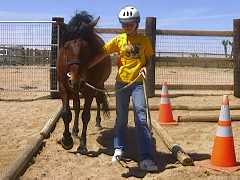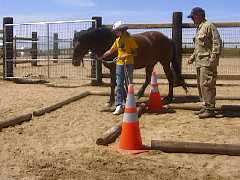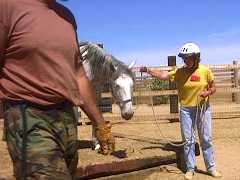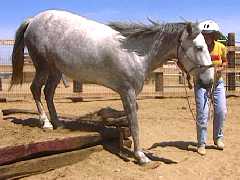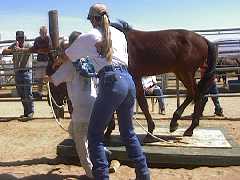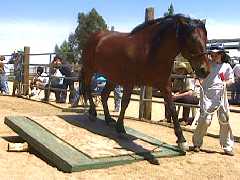Wild Horse Boot Camp Obstacles
|
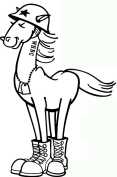
|
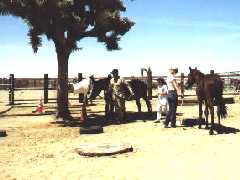 One element for effectively gentling a wild horse involves teaching him to
process a variety of stimuli and still be aware of and respond to the handler.
The horse needs to think about and navigate the obstacle and at the same time
not crowd or tune out the handler. A logical progression through the course
develops confidence in both horse and handler. This segment shows horses being worked by participants of Lifesavers'
Wild Horse Boot Camp held in May, 2001.
One element for effectively gentling a wild horse involves teaching him to
process a variety of stimuli and still be aware of and respond to the handler.
The horse needs to think about and navigate the obstacle and at the same time
not crowd or tune out the handler. A logical progression through the course
develops confidence in both horse and handler. This segment shows horses being worked by participants of Lifesavers'
Wild Horse Boot Camp held in May, 2001.
| |||
|
| |||
|
The first obstacle is a simple "U" shaped labyrinth. We tell participants to imagine a narrow
desert trail with a cliff on the outside and cactus on the inside. The objective is
for the horse and handler to navigate the course without either one pushing the other over the
edge or into the "cactus."
The horse should be left on a loose enough lead so that he can move his head and see the course. If the horse starts to crowd the handler, the handler can raise his hand near the horse's eye to create a temporary "wall." The handler has to anticipate and adjust his position on the corners since the one on the inside of a corner has to travel fewer steps than the one on the outside. The obstacle is first taken with the handler on the "inside," then the direction is reversed so that the horse is on the inside. Once the horse and handler can move through the labyrinth quietly and without crowding each other, it's time to move on to the other obstacles. |
Position, position, position!
| ||
|
| |||
|
Walking a horse through a labyrnth provides the horse with some dimensions to follow. The spool
provides a reverse stimulus... an object that makes more sense to avoid rather than walk on.
In this instance the handler uses the same cues and body position that was used in the labyrinth
to move the horse onto the spool and stop.
The spool is simply one end of a large wooden electrical cable spool that is laid on the ground. |
Stopping the horse on the spool
| ||
|
| |||
|
The mound provides the additional dimension of vertical elevation with which the horse has to contend.
While the mound is basically square, it has slightly different elevations on three sides and the fourth side has a gentle slope rather than a railroad tie step. The objectives in this obstacle include the horse "reading" the obstacle, learning to step up and down without scrambling or jumping, and maintaining position with the handler. Another element involves the fact that the handler usually can't navigate the edge of the mound at the same speed as the horse, so the horse has to be worked on a loose lead and maintain a balance between negotiating the obstacle and maintaining position with the handler. The mound is approached from various directions and the horse should take the obstacle more calmly each time it is attempted. |
Checking out the ledge
| ||
|
| |||
|
The next advance is to generate some movement in the surface that the horse is moving across.
A pole is placed under the bridge so that it rocks when the horse's weight passes the mid point
of the bridge.
The same general principles apply as with the labyrinth or mound. The horse has to read and negotiate the obstacle, and in this case, keep his balance and cool while the bridge teeters as he walks across it. Furthermore the horse needs to take the obstacle while the handler walks alongside it. The horse's position is adjusted by the body position of the handler. As one can see from these images, "Dalton," a rather large horse is moving lightly and respecting the space of a petite young lady.
Continue to Part Two |
Darice shows a student proper body position
| ||
Press "Back" to return to the page that brought you hereGo to Case Study SectionReturn to Training SectionReturn to Wild Horse MentorsReturn to KBR World of Wild Horses and BurrosGo To
| |||

